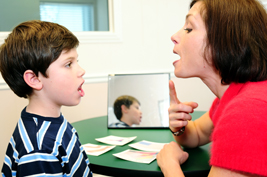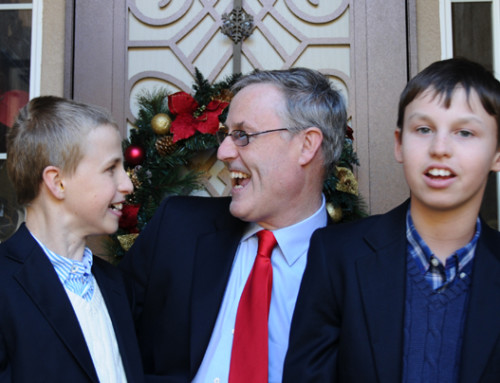What are speech/language delays and disorders?
S peech is the sound that comes out of our mouths. When it is not understood by others there is a problem. Speech problems, such as stuttering and mispronunciation can be very frustrating.
peech is the sound that comes out of our mouths. When it is not understood by others there is a problem. Speech problems, such as stuttering and mispronunciation can be very frustrating.
Language has to do with meanings, rather than sounds. Language is a measure of intelligence and language delays are more serious than speech problems.
Language delay is when a child’s language is developing in the right sequence, but at a slower rate. Speech and language disorder describes abnormal language development. Delayed speech or language development is the most common developmental problem. It affects five to ten percent of preschool kids.
- Find out exactly What is Language? What is Speech?
- Here’s more about Children with Communication Disorders.
How can I tell if my child’s speech and language development is on track?
If your child is not on track with the following speech/language development milestones, you should talk to your pediatrician.
Here are the milestones to look for in normal speech development:
| Age | Language Level |
| Birth | Cries |
| 2-3 months | Cries differently in different circumstances; coos in response to you |
| 3-4 months | Babbles randomly |
| 5-6 months | Babbles rhythmically |
| 6-11 months | Babbles in imitation of real speech, with expression |
| 12 months | Says 1-2 words; recognizes name; imitates familiar sounds; understands simple instructions |
| 18 months | Uses 5-20 words, including names |
| Between 1 and 2 years | Says 2-word sentences; vocabulary is growing; waves goodbye; makes “sounds” of familiar animals; uses words (like “more”) to make wants known; understands “no” |
| Between 2 and 3 years | Identifies body parts; calls self “me” instead of name; combines nouns and verbs; has a 450 word vocabulary; uses short sentences; matches 3-4 colors, knows big and little; likes to hear same story repeated; forms some plurals |
| Between 3 and 4 years | Can tell a story; sentence length of 4-5 words; vocabulary of about 1000 words; knows last name, name of street, several nursery rhymes |
| Between 4 and 5 years | Sentence length of 4-5 words; uses past tense; vocabulary of about 1500 words; identifies colors, shapes; asks many questions like “why?” and “who?” |
| Between 5 and 6 years | Sentence length of 5-6 words; vocabulary of about 2000 words; can tell you what objects are made of; knows spatial relations (like “on top” and “far”); knows address; understands same and different; identifies a penny, nickel and dime; counts ten things; knows right and left hand; uses all types of sentences |
If your child is not meeting these milestones, the first step is to get their hearing checked. Even if they seem to hear just fine, kids are experts at picking up visual cues to get by. It’s important to catch hearing loss early, so that treatment begins as soon as possible.
How can I tell if my child has a language problem or is just “late-bloomer”
You can’t really tell whether a child with delayed speech is a late bloomer or has an expressive language disorder or other underlying cause of speech delay. That’s why it’s worth seeking help. The earlier your child gets help, the greater their progress will be. And if they turn out to be a late bloomer, the extra attention to their speech will not have hurt in any way. Read this: Late Blooming or Language Problem? for ideas.
What causes speech and language problems?
- Developmental speech and language disorder is a common reason for speech/language problems in kids. This is a learning disability that is caused by the brain working differently. These kids may have trouble producing speech sounds, using spoken language to communicate, or understanding what other people say. Speech and language problems are often the earliest sign of a learning disability. Find out more about language-based learning disabilities.
- Hearing loss is often overlooked, and easily identified. If your child is speech/language delayed, their hearing should be tested.
- Intellectual disabililtyis a common cause of speech and language delay.
- Extreme environmental deprivation can cause speech delay. If a child is neglected or abused and does not hear others speaking, they will not learn to speak.
- Prematurity can lead to many kinds of developmental delays, including speech/language problems.
- Auditory Processing Disorder describes a problem with decoding speech sounds. These kids can improve with speech and language therapy.
- Neurological problems like cerebral palsy, muscular dystrophy, and traumatic brain injury can affect the muscles needed for speaking.
- Autism affects communication. Speech/language/communication problems are often an early sign of autism. Find out more: Autism and Communication.
- Structural problems like cleft lip or cleft palate can interfere with normal speech. More on speech development and cleft palate.
- Apraxia of speech is a specific speech disorder in which the child has difficulty in sequencing and executing speech movements.
- Selective mutism is when a child will not talk at all in certain situations, often school.
How can my child communicate, if not verbally?
Children who are nonverbal, or not communicating well enough due to hearing loss, autism, apraxia, or similar problems, can use other methods. These include sign language, the Picture Exchange Communication System (PECS), and Augmentative and Alternative Communication.
The American Sign Language Browser can help you look up signs for words you need. At the bottom of the screen, just click on the first letter of the word you want to look up, then scroll down the right hand side and click on the word you want. A video will appear to demonstrate the sign, along with a written description.
How can I help my child with language development?
 It is important to identify speech/language problems early, so your child can begin treatment. Many people believe that speech and language treatment cannot begin until a child starts talking. This is not true. Treatment can and should begin as soon as possible. Research shows that children know a lot about language long before the first word is ever said. If your child has any risk factors (for example low birth weight) or any of the problems listed above, they should be tested early and periodically for speech/language problems. If your child needs treatment, it should be developmentally appropriate and individualized. Your child’s treatment team might include a doctor, an audiologist, a speech-language pathologist, an occupational therapist, and/or a social worker.
It is important to identify speech/language problems early, so your child can begin treatment. Many people believe that speech and language treatment cannot begin until a child starts talking. This is not true. Treatment can and should begin as soon as possible. Research shows that children know a lot about language long before the first word is ever said. If your child has any risk factors (for example low birth weight) or any of the problems listed above, they should be tested early and periodically for speech/language problems. If your child needs treatment, it should be developmentally appropriate and individualized. Your child’s treatment team might include a doctor, an audiologist, a speech-language pathologist, an occupational therapist, and/or a social worker.
- Be sure to read YourChild: Learning Disabilities or Developmental Delay for information about how the school system can help your baby, preschooler, or school-age child if you have speech or language concerns.
- For more about how schools can help: FAQ: Speech and Language Disorders in the School Setting
Here are some parenting tips for helping along your child’s speech and language:
- Start talking to your child at birth. Even newborns benefit from hearing speech.
- Respond to your baby’s coos and babbling.
- Play simple games with your baby like peek-a-boo and patty-cake.
- Listen to your child. Look at them when they talk to you. Give them time to respond. (It feels like an eternity, but count to 5—or even 10—before filling the silence).
- Describe for your child what they are doing, feeling and hearing in the course of the day.
- Encourage storytelling and sharing information.
- Don’t try to force your child to speak.
- Read books aloud. Ask a librarian for books appropriate to your child’s age. If your baby loses interest in the text, just talk about the pictures.
- Sing to your child and provide them with music. Learning new songs helps your child learn new words, and uses memory skills, listening skills, and expression of ideas with words.
- Expand on what your child says. (For example, if your child says, “Elmo!”, you can say, “You want Elmo!”)
- Talk a lot to your child. Tell them what you are doing as you do it.
- Plan family trips and outings. Your new experiences give you something interesting to talk about before, during, and after the outing.
- Look at family photos and talk about them.
- Answer your child every time they speak—this rewards them for talking.
- Ask your child lots of questions.
- Use gestures along with words.
- Don’t criticize grammar mistakes. Instead, just model good grammar.
- Play with your child one-on-one, and talk about the toys and games you are playing.
- Follow your child’s lead, so you are doing activities that hold their interest as you talk.
- Have your child play with kids whose language is a little better than theirs.
What about stuttering, and how can parents help?
Stuttering (sometimes called stammering) is a speech disorder. In stuttering, the normal flow of speech is broken up by repeating or lengthening the sounds, syllables, or words. A person may also have trouble getting a word started. Most kids outgrow stuttering.
Parents can help by:
- Once in a while, talk about the stuttering in an accepting, encouraging way.
- Find out how to communicate with someone who stutters.
- Talk to your child in a slow, relaxed way.
- Take time each day to spend some relaxed, one-on-one time with your child. Follow their lead, and let them be the center of attention.
- Take turns speaking in the family, such as at dinner time—make sure family members aren’t competing for time to talk.
- Slow the pace of life in the home, especially conversations.
- If your child is getting treatment for stuttering, don’t set perfect speech as the goal. Rather, expect treatment to help your child to arrive at more natural speech, with less struggle and work.
The Stuttering Foundation has a helpful video called Stuttering and Your Child: Help for Parents
Where can I find more information and support?
 Information and organizations:
Information and organizations:
- Animated Language Learning – A Disney animation based speech and language learning program developed by the Dodd twins. This is a powerful language development tool created by a family of language disordered children for language disordered children.
- Delayed speech or language development —basic information from KidsHealth.org, including normal development, warning signs, causes, how Speech-Language Pathologists (SLPs) can help, and what parents can do.
- Speech and Language Impairments—a fact sheet with resource list from NICHCY.
- Stuttering from the National Institute on Deafness and Other Communication Disorders (NIDCD).
- El Tartamudeo, the above publication in Spanish, from the NIDCD.
- For kids: About stuttering and other speech problems from Kidshealth.org.
- ASHA’s information about stuttering includes developmental course, causes, effects on daily life, diagnosis, treatment, and support.
- The American Speech-Language-Hearing Association has lots of information on their website and can provide a referral to a speech and language pathologist.
- The Hanen Centre, based in Canada, helps young children with or at risk for language delays communicate to the best of their abilities, through interaction-based interventions. The Centre develops leading-edge programs and practical, user-friendly learning resources for parents and and professionals. Materials can be purchased on their website. Check out the tips for parents on their website.
- Apraxia-KIDS is the website of the Childhood Apraxia of Speech Association (CASANA), which offers information, support and training, and works for better public policy and research related to kids with apraxia. The Apraxia Library section of their website has a wealth of information, including tips about insurance coverage of services.
- The Stuttering Foundation of America strives to provide the most current information about prevention and treatment of stuttering in young children, teens and adults.
- The National Stuttering Association provides information and support.
- The National Institute on Deafness and Other Communication Disorders (NIDCD).
Books:
- The Late Talker, by Marilyn Agin, Lisa Geng, and Malcolm Nicholl.
Written by a developmental behavioral pediatrician and a parent, this book can help parents get services and advocate for their children with communication delays. It suggests which diagnostic codes are most likely to get health insurance companies to cover services for speech and language problems and provides resources for parents, including where to get legal aid, publications, and more information.
Related topics on YourChild:
- Learning Disabilities
- Dyslexia and Reading Problems
- Non-verbal Learning Disorders
- ADHD (Attention Deficit Hyperactivity Disorder)
- Developmental Milestones
- Developmental Delay
- Siblings of Kids with Special Needs
- Getting Involved in Your Child’s Education
- Reading and Your Child—includes child, adult and family literacy contacts
Related services at at the University of Michigan:
- Speech-Language Pathology: Speech-Language pathologists at the University of Michigan Health System assess and treat children and adults with communication and swallowing disorders.
- Pediatric Speech, Language and Feeding/Swallowing Program provides comprehensive assessment and treatment of children who experience delay or disorder in speech, language, voice, resonance, communication skills or feeding and swallowing.
References
American Speech-Language-Hearing Association. Late Blooming or Language Problem? Available at: http://www.asha.org/public/speech/disorders/LateBlooming.htm. Accessed 6 June 2008.
Coplan J. Language Delays. In: Parker S, Zuckerman B, eds. Behavioral and Developmental Pediatrics. Boston: Little, Brown, and Co.; 1995:195-199.
Guitar B, Belin-Frost G. Stuttering. In: Parker S, Zuckerman B, eds. Behavioral and Developmental Pediatrics. Boston: Little, Brown, and Co.; 1995:294-296.
Leung AK, Kao CP. Evaluation and management of the child with speech delay. Am Fam Physician. 1999 Jun;59(11):3121-8, 3135.
National Institute on Deafness and Other Communication Disorders. Stuttering. NIH Pub No 97-4232. May 2002. Available at: http://www.nidcd.nih.gov/health/voice/stutter.asp. Accessed 6 June 2008.
Written and compiled by Kyla Boyse, R.N. Reviewed by faculty and staff at the University of Michigan
Updated November 2012







Leave A Comment